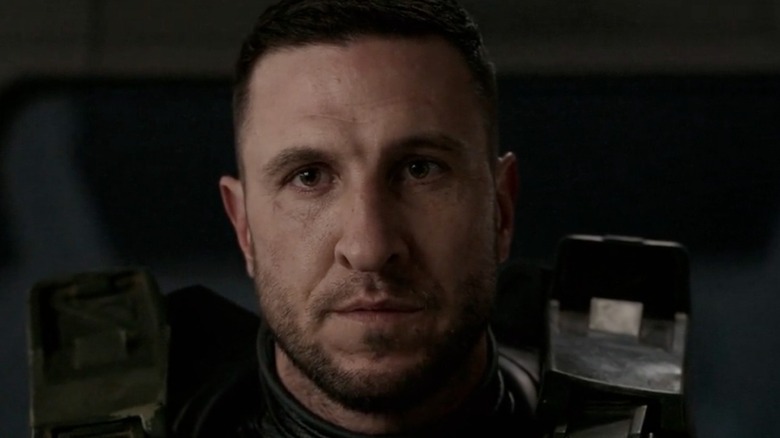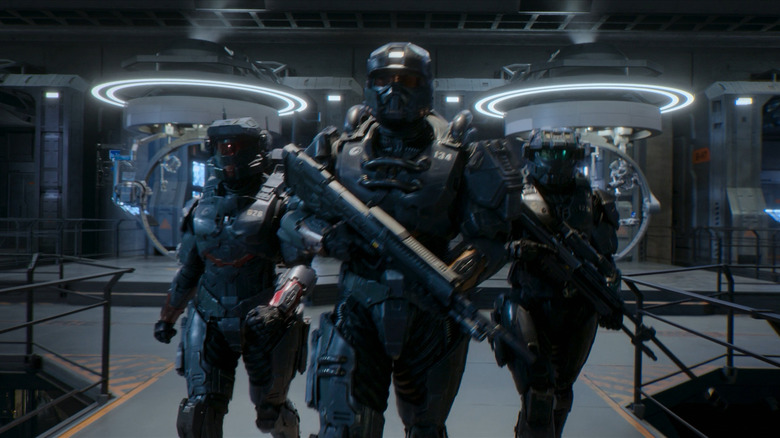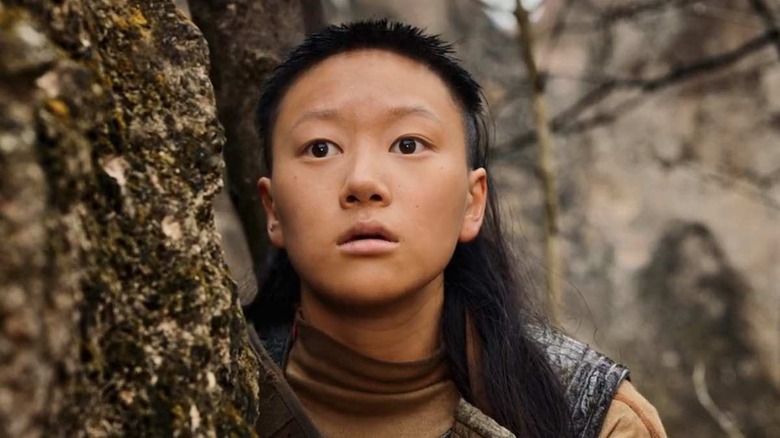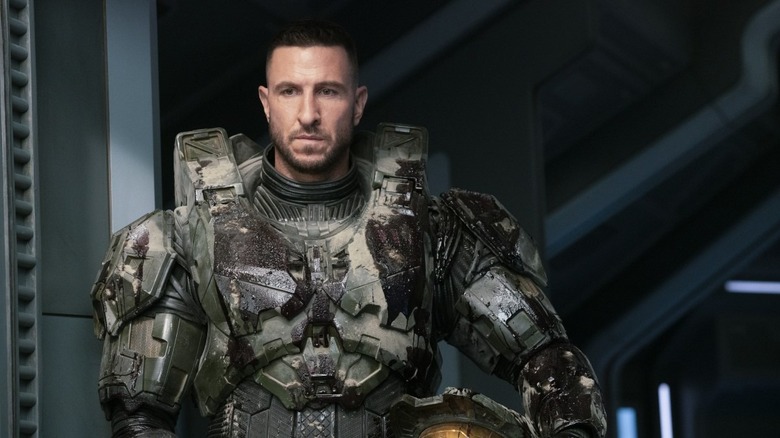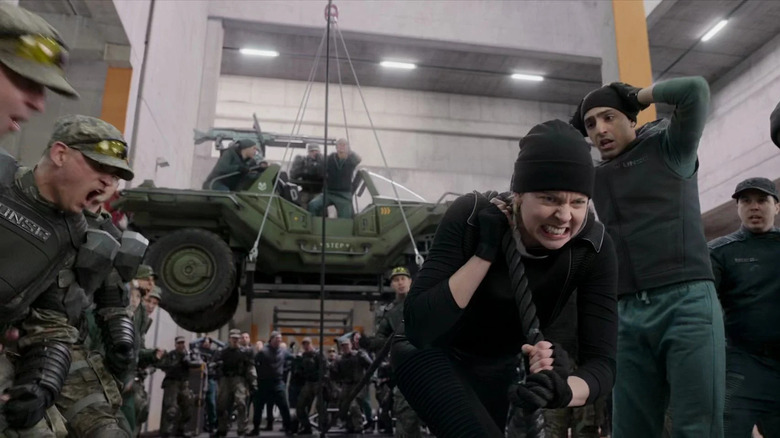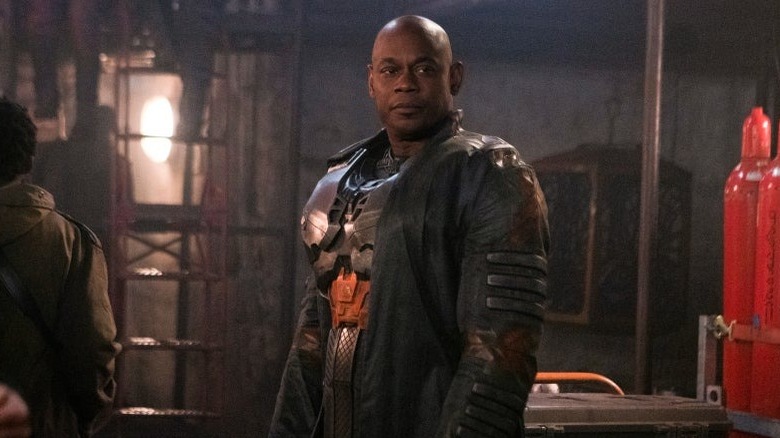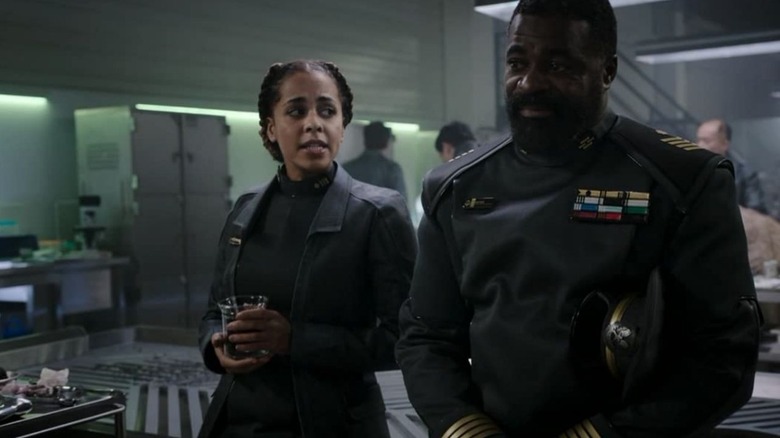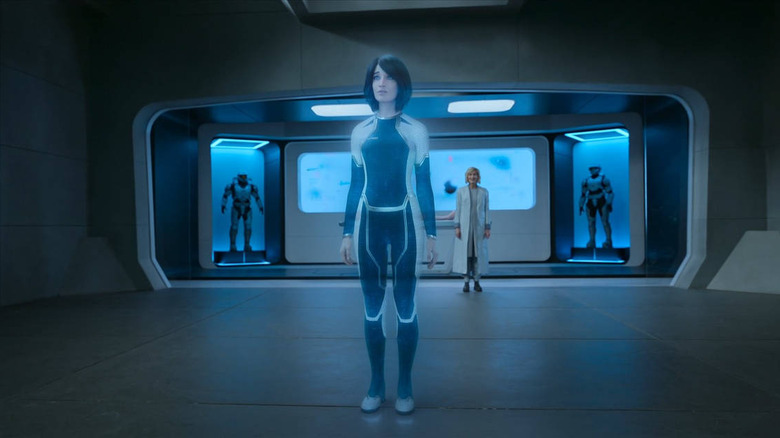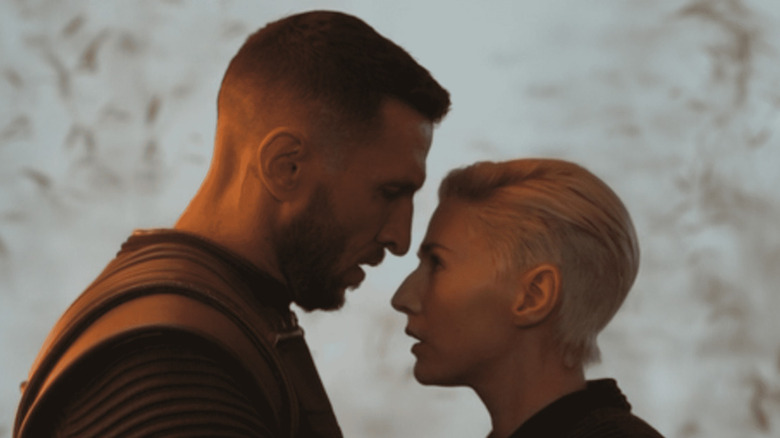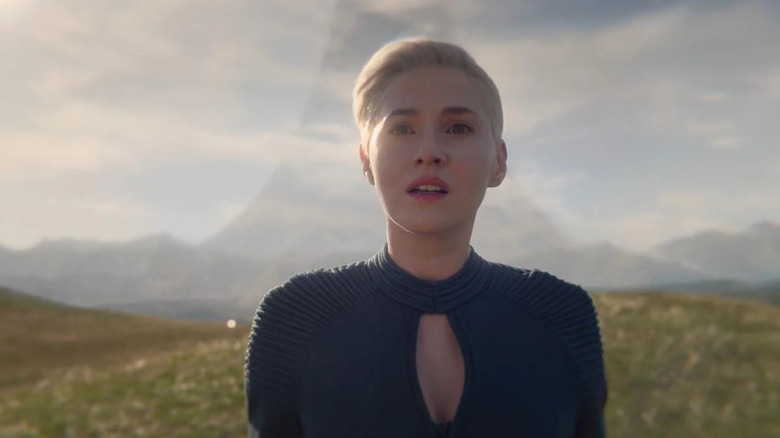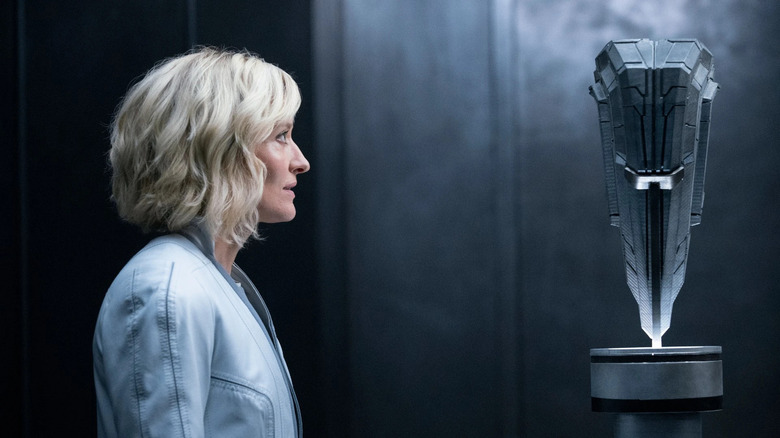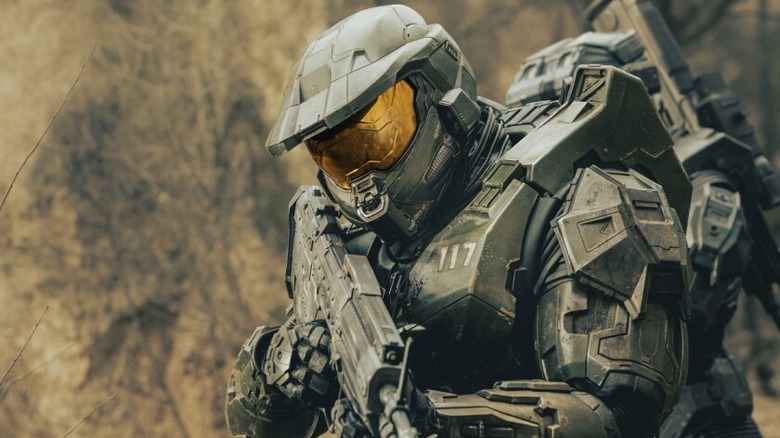Biggest Differences Between The Halo TV Series And The Games
The widely celebrated and massively popular "Halo" games have been around for over 20 years. They feature a stunning array of characters, a complex story, and truly deep lore, which fans never tire of pulling apart. Between everything established in the games and the many adventures chronicled in other "Halo" media, which ranges from books to animated shorts, the "Halo" TV series has a lot of story to work through. This is a tremendous boon, but it can also be confusing — especially to prospective fans looking to jump in without having to do a ton of homework. In the hopes of giving everything a fresh start, the "Halo" TV series establishes a new "Silver Timeline." As executive producer Kiki Wolfkill explained at IGN Fan Fest 2022, this timeline incorporates many elements of established lore while also venturing into unexplored territory.
As a result, "Halo" Season 1 makes some significant changes to the story fans have loved for decades. While every "Halo" episode is packed with Easter eggs which prove everyone working on the show has real reverence for the source material, there's no denying the production tells a very different tale than the one the games began telling all the way back in 2001. Whether you've been running and gunning with Master Chief since the early '00s or you're just now making an orbital drop into "Halo" lore, here are the biggest differences between the "Halo" TV series and the games.
Silver Team
In the early moments of "Contact," Episode 1 of the "Halo" TV series, the Covenant launches an attack on the Insurrectionist-controlled planet of Madrigal. Amidst the chaos of battle, the Master Chief arrives with a team of Spartans. Here, longtime "Halo" fans get their first look at one of the show's major changes to the game's continuity.
In the world of the "Halo" games, Master Chief is the leader of Blue Team, an elite group of Spartans which has seen its roster change many times throughout the years. In the book "Halo: The Fall of Reach," Blue Team consists of Spartans who trained alongside Master Chief as children. The original Blue Team, aside from John-117 himself, doesn't survive the Human-Covenant War. In "Halo 5: Guardians," Master Chief leads a new Blue Team made up of Spartan-IIIs.
The TV series, in contrast, sees Master Chief lead a group of Spartans called Silver Team. The change isn't just superficial: The three other Spartans on Silver Team are all original characters created for the show. Though they have limited screen time in Season 1, they each represent an opportunity for the show to tell exciting new stories within its alternate timeline.
Complicating the UNSC
The United Nations Space Command, or UNSC, is one of the most prominent human organizations in the "Halo" series. They are the de-facto government of the human race and act as humanity's primary defense against the Covenant. But in the years before the Covenant War began, the UNSC fought against Insurrectionists across many planets. As "Halo: The Fall of Reach" reveals, the Spartans were, in fact, originally designed to put an end to the Insurrectionist War. While extended universe content has revealed some details about the Insurrectionists, the "Halo" games have thus far left their story largely unexplored.
The "Halo" TV series takes a very different tack in this regard: It puts the conflict between the UNSC and the Insurrectionists at the forefront of its story. "Contact" introduces Kwan Ha (Yerin Ha), the daughter of an Insurrectionist leader, as a main character. Her desire to lead a new rebellion against the UNSC is even one of Season 1's major plotlines. Though Kwan comes to realize that the threat of the Covenant is too much for humanity to handle without the assistance of the UNSC, her outsider perspective allows the show to highlight the human-to-human conflict brewing beneath the surface of the Human-Covenant War.
John's identity crisis
"Halo" Season 1 is really all about John-117 (Pablo Schreiber) coming to terms with his identity. The show keeps much of his backstory, and the history of the Spartan program as a whole, in line with what the "Halo" games and extended universe present. However, it explores that history in a very unique way. In "Contact," John encounters an alien artifact that unlocks his childhood memories. The more John comes into contact with the enigmatic artifact, the more he begins piecing together the truth of what Dr. Catherine Halsey (Natascha McElhone) and the UNSC did in order to create the Spartans.
In contrast, the "Halo" games don't tell fans about Master Chief's tragic backstory, or that of the other Spartans. That information is primarily relegated to extended universe content like "Halo: The Fall of Reach." During the events of the games, Master Chief is simply too busy fighting the Covenant to spend much time on his past. By opening up his backstory in Season 1, the "Halo" TV series not only introduces new fans to his origins, it forces the man himself to figure out his own reasons for fighting on behalf of the UNSC. John's exploration of his past puts his characterization at the forefront of the show.
Kai-125
One of the highlights of the "Halo" TV series is Spartan Kai-125 (Kate Kennedy). Kai is a member of Silver Team, and is shown to be more loyal to Master Chief than any of the other Spartans. She's one of the first people to notice how Master Chief is changing, but she sees these changes in a positive light. After Kai witnesses him removing a hormone-suppressing pellet from his back, she secretly follows suit and begins to experience her own transformation.
Kai's arc in Season 1 of the "Halo" TV series runs parallel to John's, and makes an important theme of the series clear. Master Chief may have a special connection to the alien artifact at the heart of the season, but Kai shows that all Spartans have the potential to become fully human lurking within them. She also demonstrates that getting in touch with humanity can be an asset to the Spartans as a team. We don't know where "Halo" will go with Kai's story, but now that she's freed from her Spartan conditioning, she'll likely become an even more important character.
Soren-066
The "Halo" games never shed much light on the first generation of Spartans. In part, this is because the games take place after the events of "Halo: The Fall of Reach," which sees Master Chief lose most of his friends in battle. The show, in contrast, spends much more time with the Spartans, and has been able to highlight some characters who previously only appeared in extended universe content. Soren-066 (Bokeem Woodbine), who's introduced in the short story "Pariah," is one such figure.
The "Halo" TV series changes most of the important details about Soren-066's life. Here, he acts as a foil for Master Chief. After the Spartans were given their genetic augmentations and sent into battle against the Covenant, Soren decided to leave the UNSC behind. Episode 2, "Unbound," reveals that Master Chief planned on leaving with Soren, but decided at the last moment that he needed to continue working with the UNSC. After making his escape, Soren becomes committed to living for himself. When he and John come face-to-face years later, both of them are forced to confront the decisions they made as teenagers, and to reflect on how their lives have turned out. Season 1 doesn't wrap up Soren's story in a significant way, but as a Spartan on the outside of the UNSC, there's no doubt viewers will be seeing him again.
Miranda Keyes
Miranda Keyes, daughter of Captain Jacob Keyes and Dr. Catherine Halsey, is introduced in "Halo 2" after her father is killed on a Halo ring during the events of the first game. Keyes proceeds to take over her father's role as a commanding officer. In "Halo 3," she's one of humanity's top wartime strategists, and helps direct the Marines fighting alongside Master Chief. Since she's such a major character in the second and third "Halo" games, it's no surprise she's part of the TV series. But the Miranda Keyes of the "Halo" show is nearly unrecognizable to anyone who's played the "Halo" games.
The games don't give Keyes the opportunity to interact with her father, and they never explore her relationship with Dr. Halsey. The TV series, on the other hand, makes those two relationships utterly central to her character. This Keyes (Olive Gray) is a brilliant scientist studying the Covenant, who's locked in quasi-competition with her mother for the UNSC's limited resources. Her relationship with both of her parents becomes even more complicated when she discovers what both of them did to launch the Spartan program. With Dr. Halsey out of the picture — at least for a little while — Miranda Keyes will be the UNSC's top scientist when Season 2 begins.
Cortana's real purpose
Aside from Master Chief himself, Cortana is the most important character in the "Halo" games. She's such a big deal, she's introduced in the very first cut scene of the entire series. At the beginning of that first game, she's working as the AI for the ship Pillar of Autumn, but as the story marches onward, she's revealed to be playing a much larger role in the war effort. Throughout the games, Cortana and Master Chief work as partners in taking down the Covenant. In the opening cut scene of "Halo 3," Cortana even reveals she had the option of working with any Spartan she wanted, and specifically chose Master Chief.
The "Halo" TV series takes Cortana's character in an entirely different direction. Dr. Halsey creates Cortana (Jen Taylor) and decides that she and Master Chief will work together. Ultimately, Dr. Halsey plans for Cortana's AI consciousness to take control of Master Chief's augmented body, resulting in a powerful weapon to be used against the Covenant. The show slowly builds a relationship between Cortana and Master Chief until the AI is willing to turn her back on her programming to work in tandem with the super soldier. The ending of "Halo" Season 1 finds Cortana unwillingly in control of Master Chief's body, which means Season 2 will likely see her struggle to bring John back.
The Blessed Ones
The "Halo" TV series makes plenty of changes to the games' lore, but the introduction of the Blessed Ones might be the biggest change of all. Blessed Ones are human beings with a special connection to Forerunner artifacts and technology. Master Chief is a Blessed One, which is why his memories and emotions are apparently unlocked when he comes into contact with an alien artifact.
The only other known Blessed One is a woman named Makee (Charlie Murphy). The Covenant abducted Makee as a young girl and raised her as one of their own, hoping to use her status as a Blessed One to help them find a Halo ring. They send Makee back to humanity, intending for her to work as a double agent — but when she meets Master Chief, the two quickly bond over their traumatic childhoods and strange connection to Forerunner technology.
The relationship between Makee and Master Chief is one of the TV series' most controversial changes to the "Halo" story, which executive producer Kiki Wolfkill acknowledged in an interview with Deadline. Still, the fact remains that Makee has one of Season 1's most developed character arcs. The events she helps put in motion are likely to set the course of the TV series moving forward.
Finding Halo
Most "Halo" fans were likely expecting to see a lot more Halo in Season 1 of the TV series. After all, "Halo: Combat Evolved" begins with the human ship Pillar of Autumn arriving at the titular ring. Players proceed to spend most of the first game unlocking its secrets. Most games in the series spend at least some portion of time on a Halo installation, to the point that the rings might be even more closely associated with the franchise than Master Chief himself.
The "Halo" TV series is taking things at a much slower pace than the games, however. In "Contact," Master Chief snatches a Forerunner artifact from invading Covenant forces. The Covenant, it turns out, needs the artifact in order to find Halo. Throughout Season 1, Master Chief and the UNSC begin piecing together what Halo is and why the Covenant wants to find it. Master Chief has several visions of Halo, which means fans get a glimpse of iconic imagery — but the location of the ring itself remains a mystery.
By the end of Season 1, humanity knows that Halo is some kind of weapon, and is desperate to get to it before the Covenant does. The search for Halo is likely going to be a major plot arc going forward — as longtime fans know, finding the ring is only the beginning.
Halsey's betrayal
Dr. Catherine Halsey is the UNSC's top scientist, but she's also a giant liability to the entire organization. Dr. Halsey values her work and ideas about progress above all else, to the point that she's more than willing to bend and even break rules in order to achieve her goals. Her Spartan program helps humanity win the Covenant War, but in the games, her actions come under scrutiny when the conflict ends. The opening cinematic of "Halo 4" shows Dr. Halsey being interrogated about her work with the Spartans.
The "Halo" TV series doesn't change the most essential aspects of Dr. Halsey's character, but it does put her at odds with the UNSC much earlier in the story's timeline. As John begins to remember how he and the other Spartans were brought into the program, his loyalty to Dr. Halsey dissolves. The UNSC turns its back on Dr. Halsey as her actions come to light, and plans to send her to a top secret site to continue her research out of the public eye.
Dr. Halsey losing John and the UNSC's faith is a dramatic change from the story presented in the "Halo" games, but the TV series doesn't stop there. Dr. Halsey lashes out at John, ordering the other Spartans to attack him, and leaves the UNSC on her own terms. Now she's in hiding, quietly pursuing her own plans for the future of the species.
John's death
The ending of "Halo" Season 1 simultaneously makes a dramatic break from the games' continuity and pushes one character into his classic role. In the midst of a massive battle against the Covenant, Master Chief realizes he needs to be able to fight while also carrying the Forerunner artifacts out of the battlefield. Since he's unable to touch the artifacts without losing control of his body, he lets Cortana take over his mind so that she can do what needs to be done to finish the fight.
When the season ends, Cortana is in control of Master Chief, and John's fate is unclear. He might be truly dead, or he might just be trapped somewhere deep beneath the surface of Cortana's consciousness. Killing off John would be a shocking departure from the games, but at the same time, this new version of Master Chief acts much more like his video game self. Cortana-Chief is stoic and focused on fighting and achieving objectives above all else — a persona longtime "Halo" fans know well. It's a safe bet John will make a comeback in Season 2, but for now, the silent Master Chief has finally made his way onto the "Halo" TV series.

